|
KIT: |
Trumpeter 1/350
USS Lexington (May 1942) |
|
KIT #: |
05608 |
|
PRICE: |
$129.95 |
|
DECALS: |
provided for
aircraft only |
|
REVIEWER: |
Scott Van Aken |
|
NOTES: |
A lot of you have
been waiting, now here it is! |

displacement: 41,000 tons
length: 888 feet
beam: 105½ feet
draft: 32 feet
speed: 34¼ knots
complement: 2,122 crew
armament: 8 eight-inch and 12 five-inch guns (as originally fitted)
aircraft: 81
class: Lexington
From: Dictionary of American
Fighting Ships, published by the
Naval Historical Center
Full-screen images are linked from the images in the text below.
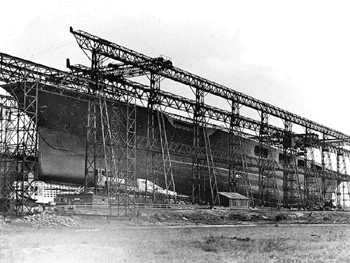
The fourth Lexington (CV 2)
was originally designated CC 1; laid down as a battle cruiser 8 January
1921 by Fore River Shipbuilding Co., Quincy, Mass.; authorized to be
completed as an aircraft carrier 1 July 1922; launched 3 October 1925;
sponsored by Mrs. Theodore Douglas Robinson, wife of the Assistant
Secretary of the Navy; and commissioned 14 December 1927, Capt. Albert W.
Marshall in command.
After fitting out and shakedown,
Lexington joined the battle fleet at San Pedro, Calif., 7 April 1928.
Based there, she operated on the west coast with Aircraft Squadrons, Battle
Fleet, in flight training, tactical exercises, and battle problems . Each
year she participated in fleet maneuvers in the Hawaiians, in the
Caribbean, off the Panama Canal Zone, and in the eastern Pacific.
On 16 January 1930, Lexington
completed a 30-day period in which she furnished electricity to the city of
Tacoma, Wash., in an emergency arising from a failure of the city's power
supply. The electricity from the carrier totaled more than 4.25 million
kilowatt-hours.
In the fall of 1941 she sailed with
the battle force to the Hawaiians for tactical exercises.
On 7 December 1941 Lexington
was at sea with Task Force 12 (TF 12) carrying marine aircraft from Pearl
Harbor to reinforce Midway when word of the Japanese attack on Pearl Harbor
was received. She immediately launched searchplanes to hunt for the
Japanese fleet , and at mid-morning headed south to rendezvous with USS
Indianapolis (CA 35) and
USS Enterprise (CV 6) task forces to conduct a search southwest
of Oahu until returning Pearl Harbor 18 December.
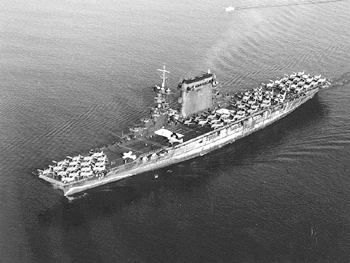 Lexington sailed next day to
raid Japanese forces on Jaluit to relieve pressure on Wake; these orders
were canceled 20 December, and she was directed to cover the
USS Saratoga force in reinforcing Wake. When the island fell 23
December, the two carrier forces were recalled to Pearl Harbor, arriving 27
December.
Lexington sailed next day to
raid Japanese forces on Jaluit to relieve pressure on Wake; these orders
were canceled 20 December, and she was directed to cover the
USS Saratoga force in reinforcing Wake. When the island fell 23
December, the two carrier forces were recalled to Pearl Harbor, arriving 27
December.
Lexington patrolled to block
enemy raids In the Oahu-Johnston-Palmyra triangle until 11 January 1942,
when she sailed from Pearl Harbor as flagship for Vice Adm. Wilson Brown
commanding TF 11. On 16 February, the force headed for an attack on Rabaul,
New Britain, scheduled for 21 February. While approaching the day previous,
Lexington was attacked by two waves of enemy aircraft, nine planes
to a wave. The carrier's own combat air patrol and antiaircraft fire
splashed 17 of the attackers. During a single sortie Lt. E. H (Butch)
O'Hare won the Medal of Honor by downing five planes.
Her offensive patrols in the Coral
Sea continued until 6 March, when she rendezvoused with USS Yorktown's
TF 17 for a thoroughly successful surprise attack flown over the Owen
Stanley mountains of New Guinea to inflict heavy damage on shipping and
installations at Salamaua and Lae 10 March. She now returned to Pearl
Harbor, arriving 26 March 1942. Lexington's task force sortied from
Pearl Harbor 15 April, rejoining TF 17 on 1 May. As Japanese fleet
concentrations threatening the Coral Sea were observed, Lexington
and
USS Yorktown (CV 5) moved into the sea to search for the enemy's
force covering a projected troop movement. The Japanese must now be blocked
in their southward expansion, or sea communication with Australia and New
Zealand would be cut, and the dominions threatened with invasion.
On 7 May 1942 search planes reported
contact with an enemy carrier task force, and Lexington's air group
flew an eminently successful mission against it, sinking light carrier
Shoho. Later that day, 12 bombers and 15 torpedo planes from still-unlocated
heavy carriers Shokaku and Zuikaku were intercepted by
fighter groups from Lexington and Yorktown, who splashed nine
enemy aircraft.
On the morning of the 8th, a
Lexington plane located the Shokaku group. A strike was
immediately launched from the American carriers, and the Japanese ship was
heavily damaged.
 The enemy penetrated to the American
carriers at 1100, and 20 minutes later Lexington was struck by a
torpedo to port. Seconds later, a second torpedo hit to port directly
abreast the bridge. At the same time, she took three bomb hits from enemy
dive bombers, producing a seven degree list to port and several raging
fires. By 1300 her skilled damage control parties had brought the fires
under control and returned the ship to even keel. Making 25 knots, she was
ready to recover her air group. Then suddenly Lexington was shaken
by a tremendous explosion, caused by the ignition of gasoline vapors below,
and again fire raged out of control.
The enemy penetrated to the American
carriers at 1100, and 20 minutes later Lexington was struck by a
torpedo to port. Seconds later, a second torpedo hit to port directly
abreast the bridge. At the same time, she took three bomb hits from enemy
dive bombers, producing a seven degree list to port and several raging
fires. By 1300 her skilled damage control parties had brought the fires
under control and returned the ship to even keel. Making 25 knots, she was
ready to recover her air group. Then suddenly Lexington was shaken
by a tremendous explosion, caused by the ignition of gasoline vapors below,
and again fire raged out of control.
At 1558 Capt. Frederick C. Sherman,
fearing for the safety of men working below, secured salvage operations,
and ordered all hands to the flight deck. At 1707, he ordered, "abandon
ship!", and the orderly disembarkation began, men going over the side into
the warm water, almost immediately to be picked up by nearby cruisers and
destroyers. Admiral Fitch and his staff transferred to cruiser USS
Minneapolis (CA 36); Captain Sherman and his executive officer, Cmdr.
M. T. Seligman insured all their men were safe, then were the last to leave
their ship.
Lexington blazed on, flames
shooting hundreds of feet into the air. The destroyer USS Phelps (DD
360) closed to 1500 yards and fired two torpedoes into her hull. With one
last heavy explosion, Lexington sank at 1956 on 8 May 1942 at 15º
20' S., 155º 30' E. She was part of the price that was paid to halt the
Japanese overseas empire and safeguard Australia and New Zealand, but
perhaps an equally great contribution had been her pioneer role in
developing the naval aviators and the techniques which played so vital a
role in ultimate victory in the Pacific.
Lexington received two battle
stars for World War II service.
Historical background courtesy of the
Naval Historical Center.
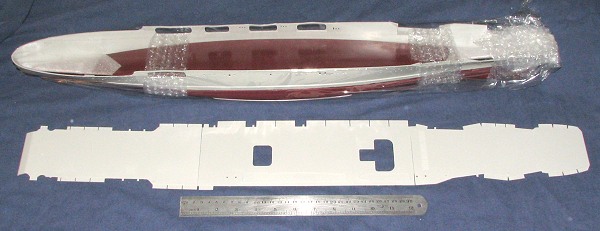
I'd have to say that Trumpeter has
done it again. Now I'm at a bit of a disadvantage to many of you as ships
are not my forte, however, it seems from what I've heard and seen regarding
their other nautical releases, that Trumpeter gets things done pretty much
spot on when it comes to the design of its ship models. You'll have to
excuse my not showing all the sprues, but there just isn't room for them.
I've shown the hull as packaged and the flight deck. That is a one foot
ruler
Since the Lex and Sara were based on
battle cruiser hulls, it should be no surprise that these are both long and
skinny ships. As a result, the length of the hull is nearly a meter long.
Finding a spot for this one will be a real challenge for modelers. The
level of detailing is excellent, just as we have come to expect from
Trumpeter kits. There are the usual mass of ejector pin marks on the
backside of parts and filling those for the deck bits that stick out will
be a chore for those who want to have a contest quality model. Most of us
will blow them off.
This is the Lexington as she was at
the Coral Sea. This means no big guns, those being replaced by additional
anti-aircraft guns. You get a nice batch of aircraft to go along with it.
Nothing like the normal complement of 81, but you do get 6 SBD-3s, 4
F4F-4s, and 3 TBD-1s. Naturally, those who want a busy flight deck will be
able to get extras as 13 planes will not look very crowded on that deck!
Even though you can do the wings folded on the TBD and F4Fs, you'll want
the wings fixed on the Wildcats as the F4F-4 with the folding wings didn't
come until Midway, and the Lex was sunk at the Battle of the Coral Sea.
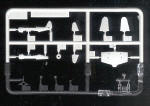 I've
shown the TBD sprue and should note that the instructions would have the
folded wings being vertical when done. This isn't correct for the TBD as
the tips met over the canopy when the wings were folded. You may have to do
these with the wings spread. The build instructions for the TBD also show
an SBD for the first half of the build (guess they figured we wouldn't
notice!). Trumpeter also missed the corrugated wings and tail planes.
I've
shown the TBD sprue and should note that the instructions would have the
folded wings being vertical when done. This isn't correct for the TBD as
the tips met over the canopy when the wings were folded. You may have to do
these with the wings spread. The build instructions for the TBD also show
an SBD for the first half of the build (guess they figured we wouldn't
notice!). Trumpeter also missed the corrugated wings and tail planes.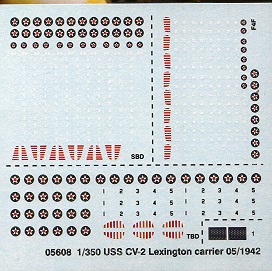
As with previous Trumpeter ships,
this one can be built with a full hull or as a waterline. The flight deck
is in three sections that interlock with each other, providing a good
mating surface that should require no filler. In terms of sheer parts, most
of what is in the kit are for the AA guns and for the aircraft. Regardless,
it should be a relatively quick build once the bits have had the usual seam
scraping and other general cleaning prior to construction. I did note that
the large openings on the side were very thin near the top and were warped.
Careful construction should amend that.
Instructions are excellent with four
of the 20 pages being devoted to a parts guide. Then you get into the 21
construction steps, three of which are for the aircraft. No color
information is given during the construction phase. For that, there is a
separate sheet in full color showing Gunze paints that are to be used. They
show the area below the waterline as cocoa brown. I'd always thought that
was red. The deck is given as 'Deck Blue' so I guess that Gunze has a few
naval colors as well. There are decals for the air wing and they are quite
well printed. They are also teeny tiny so break out the magnifying glass
for this one!
I know a lot of folks have been taken
aback at the high cost of Trumpeter's airplane kits. Perhaps it is
justified, but in today's shrinking hobby, I don't think it is as bad as it
seems. Certainly ship builders are getting a bargain. In the past, one
either did without or forked out many times the asking price for this one.
In terms of the quality of the kit, the detail that is provided and the
subject matter, I think that ship builders should be flocking to pick this
one up.
February 2005
Naval Historical Center.
A big thank you to Steven's International, importer of
Trumpeter and other fine hobby lines.
If you would like your product reviewed fairly and quickly by a
site that has 300,000 visitors a month, please
contact
me or see other details in the
Note to
Contributors.
Back to the Main Page
Back to the Previews Index Page





 I've
shown the TBD sprue and should note that the instructions would have the
folded wings being vertical when done. This isn't correct for the TBD as
the tips met over the canopy when the wings were folded. You may have to do
these with the wings spread. The build instructions for the TBD also show
an SBD for the first half of the build (guess they figured we wouldn't
notice!). Trumpeter also missed the corrugated wings and tail planes.
I've
shown the TBD sprue and should note that the instructions would have the
folded wings being vertical when done. This isn't correct for the TBD as
the tips met over the canopy when the wings were folded. You may have to do
these with the wings spread. The build instructions for the TBD also show
an SBD for the first half of the build (guess they figured we wouldn't
notice!). Trumpeter also missed the corrugated wings and tail planes.